27 results
12th grade chemistry resources for Montessori
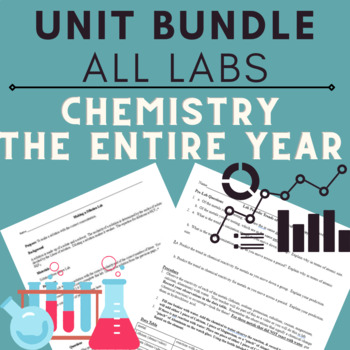
BUNDLE: High School Chemistry Labs -- THE ENTIRE YEAR for Every Unit (41 Labs!!)
Outline of each Unit to Lab Match:Introduction: Scientific Method LabIntroduction: Accuracy and Precision LabConversions: Converting Everyday Objects.Conversions: Conversion Version 2 - Using your own conversion factors.Matter & Changes: Density LabMatter & Changes: Mixture Separation Chromatography LabMatter & Changes: Physical and chemical Changes LabThe Atom: Isotope Activity/LabThe Atom: How Thick is Aluminum Foil? LabThe Atom: Online Atom Builder LabNuclear: Iodine Clock for Dec
Subjects:
Grades:
8th - 12th, Higher Education
Types:
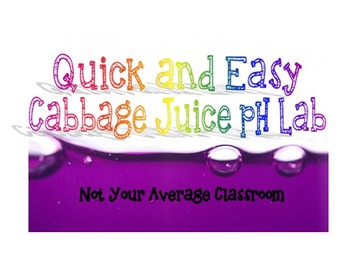
Quick and Easy Cabbage Juice pH Indicator Lab
This activity results in impressive color changes and is really fun to do! Students will use cabbage juice to test various substances for acidity or alkalinity. Purple cabbage juice turns bright pink for acids and bright blue for bases. This lab lists vinegar, tap water, baking soda solution, lemon/lime soda, and bleach solution - but you can easily convert the file to a word document and edit as needed.
This is a completely qualitative lab, and it is meant to be done in very little time. The ac
Subjects:
Grades:
5th - 12th
Types:

LAB Chemistry Density of Pennies - with Graphing & Demos
Engage your chemistry students by having them determine the composition of pennies as it changed over time. Students will chart & graph their results. After, you can demonstrate and prove that pennies are made of zinc internally.Included:3 page Student worksheet with procedure, chart, graph & analysis questions1 page teacher density demonstrations (5 easy options)Materials: pennies 13 pre 1982 & 13 post 1982 (per group or 1 set every two groups & switch pennies)graduated cylinder
Subjects:
Grades:
4th - 12th, Higher Education
Types:
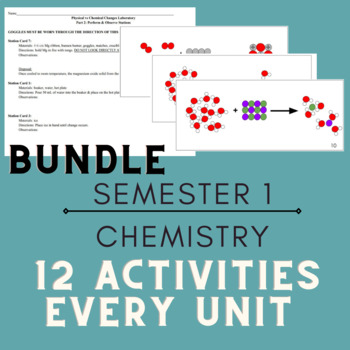
BUNDLE: High School Chemistry Semester 1 Activities (Every Unit- 12 Activities!)
Outline of each Unit to Activity Match:*computers Required for 4 activities!!*Introduction: Equipment IdentificationMatter & Changes: Tricky Mixtures StationsMatter & Changes: Physical vs Chemical Particle Diagram Identification x 2The Atom: Online Atom Builder Nuclear/Radioactivity: 1 Day Poster Research ProjectElectrons: Bohr Models & Electron Configuration RelationshipsElectrons: BattleshipPeriodic Table: Coloring Groups/FamiliesChemical Bonding: Building Molecules with Model Kits
Subjects:
Grades:
8th - 12th, Higher Education
Types:
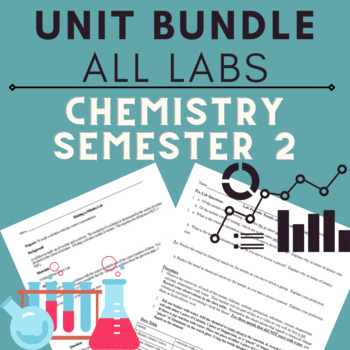
BUNDLE: High School Chemistry Semester 2 Labs; Labs for Every Unit (20 Labs!!)
Outline of each Unit to Lab Match:Moles: Chalk Name & Body LabMoles: Molar Volume ConversionStoichiometry: Decomposition of Baking Soda LabLimiting Reactants: Limiting Reactant LabGases: 8 Stations Gas LawsGases: Exploring Variable Relationships (online)Gases: DiffusionGases: Gas Stoichiometry DesignSolutions: Properties of WaterSolutions: Calculate MolaritySolutions: Make a Solution & DilutionSolutions: Make Ice CreamAcids & Bases: pH of common materialsAcids & Bases: Mini Soda
Subjects:
Grades:
8th - 12th, Higher Education
Types:

LAB Chemistry - Equilibrium Le Chatlier's Principle
Engage your chemistry students by having them performing an equilibrium shift. This lab is empowering because students can SEE the shift right before their eyes. This lab does require quite a bit of set up, but is well worth the effort.Included:1 sheet Lab 2 pagesObjective: Observe and determine the equilibrium shift of the reactionMaterials test tube tongs droppers0.1 M &g Iron (III) Nitrate 0.1 M KSCN 0.1 M NaOH 0.1 M Silver Nitrate 0.5 g KClWater 7 Test Tubes Test Tube Rack Stirring Ro
Subjects:
Grades:
8th - 12th, Higher Education
Types:

LAB Chemistry - Nuclear Decay - Wet Lab
Engage your chemistry students by having them performing an iodine clock reaction -- reimaged to be assigned to nuclear decay! Students will time the clock, graph the results and imagine how the nucleus decays over time.Included:1 sheet Lab 2 pages1 Sheet teacher solution creation directionsObjective: Observe and determine the equilibrium shift of the reactionMaterials Students:• Solution A• Solution B• 2 Erlenmeyer flasks• 3 graduated cylinders • A magnetic stirrer (if available) Timer• Beaker•
Subjects:
Grades:
8th - 12th, Higher Education
Types:
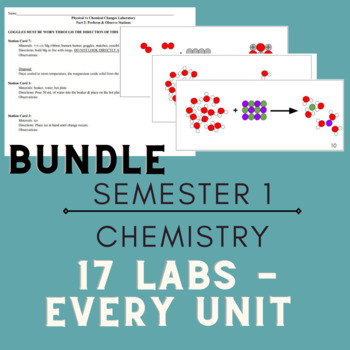
BUNDLE: High School Chemistry Semester 1 Labs; Labs for Every Unit (22 Labs)
Outline of each Unit to Lab Match:Introduction: Scientific Method LabIntroduction: Accuracy and Precision LabConversions: Converting Everyday Objects.Conversions: Conversion Version 2 - Using your own conversion factors.Matter & Changes: Density LabMatter & Changes: Mixture Chromatography LabMatter & Changes: Physical and chemical Changes LabThe Atom: Isotope Activity/LabThe Atom: How Thick is Aluminum Foil? LabThe Atom: Online Atom Builder LabNuclear: Iodine Clock for Decay LabElect
Subjects:
Grades:
8th - 12th, Higher Education
Types:
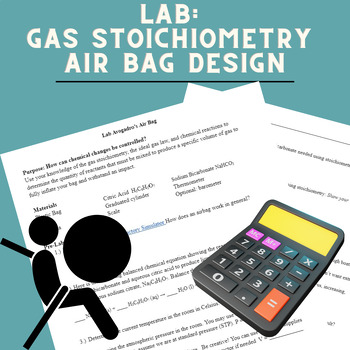
LAB Chemistry Gas Stoichiometry & Gas Laws - Design an Air Bag
Engage your chemistry students by having them observe and perform an inquiry experiment using gas stoichiometry & gas laws to design their own airbag.Be sure to test them by dropping items upon them!MaterialsCitric Acid H3C6H5O7 (grocery)Sodium Bicarbonate NaHCO3 (grocery)Water Graduated cylinderScoopula Plastic Baggies with sealThermometerScale
Subjects:
Grades:
9th - 12th, Higher Education
Types:
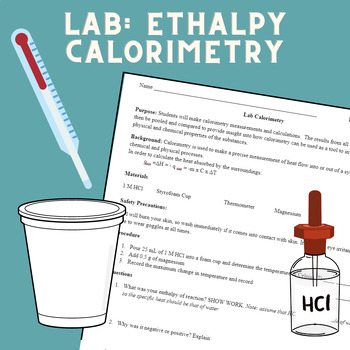
LAB Chemistry Simple Calorimetry (Heat & Enthalpy)
Engage your students by having them observe and perform a small scale calorimetry experiment.Objective: Students will make calorimetry measurements and calculations. The results from all students can then be pooled and compared to provide insight into how calorimetry can be used as a tool to investigate the physical and chemical properties of the substances.Materials1 M HCl Foam CupThermometerZinc OR MagnesiumCalculator
Subjects:
Grades:
9th - 12th, Higher Education
Types:
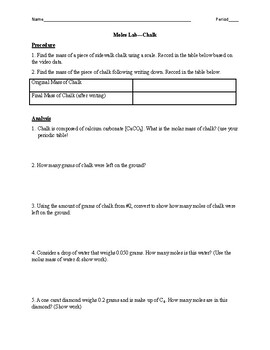
LAB Chemistry - Moles in My Name & Body!
Engage your chemistry students by having them calculate the amount of moles in their name by writing outside with sidewalk chalk, then calculate how many moles are in their own bodies! An easy twist on a classic lab.Included:Lab Worksheet 2 pagesObjective: Calculate the amount of moles in your name & bodyMaterials:scales/balancesSidewalk Chalk (or normal)This activity can be adjusted to play outside or also to write their name onto a piece of paper,
Subjects:
Grades:
8th - 12th, Higher Education
Types:
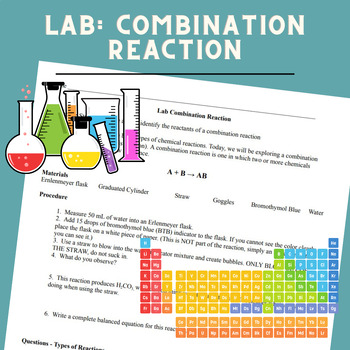
LAB Chemistry - Easy Combination Reaction
Engage your chemistry students by having them perform a quick combination reaction, with a fun color change. This gets students up and moving with easy setup & safety measures. They will write out a full equation for the reaction observed (problem solving) as well as a quick balancing practice.Objective: Observe and predict the reactants of a combination reactionMaterials:Erlenmeyer flaskGraduated CylinderStrawBTB (bromothymol blue) Water
Subjects:
Grades:
7th - 12th, Higher Education
Types:
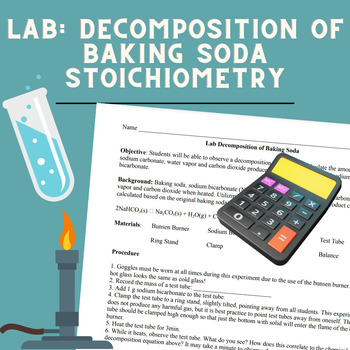
LAB Chemistry - Stoichiometry - Decomposition of Baking Soda with Calculations
Engage your chemistry students by having them perform a decomposition of baking soda by burning it. This will release water (which they will see as condensation), sodium carbonate and CO2. After performing, student will find the percent yield of sodium carbonate and the amount in liters at STP of water vapor and CO2 using stoichiometry.Objective: Students will be able to observe a decomposition reaction and calculate the amount of sodium carbonate, water vapor and carbon dioxide produced from a
Subjects:
Grades:
9th - 12th, Higher Education
Types:
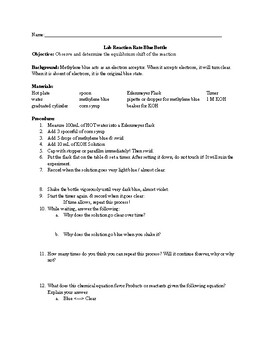
LAB Chemistry - Equilibrium Reaction Rates, Le Chatlier, Equilibrium Constant
Engage your chemistry students by having them performing an equilibrium shift. This lab is empowering because students can SEE the shift right before their eyes. This lab is quick and EASY to set up & the students enjoy the continuous changes. Teacher Note: Every shake adds oxygen back into the reaction!Included:1 sheet Lab 2 pagesObjective: Observe and determine the equilibrium shift of the reactionMaterials Hot plate spoon Erlenmeyer Flask Timerwater methylene blue pipette or drop
Subjects:
Grades:
8th - 12th, Higher Education
Types:
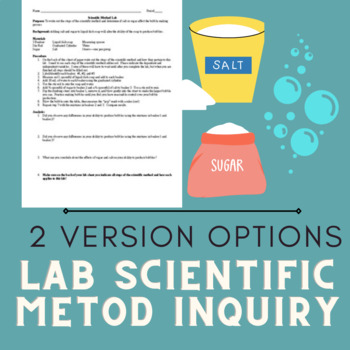
LAB Scientific Method Inquiry, Bubble Blowing - Engaging - 2 Different Versions!
This lab has students investigate what can form the biggest bubble using the scientific method - sugar or salt with regular water as a control. This can be edited to use any ingredients students wish to test as well! Simple and quick lab that has students thinking.Two Versions:1: Directions Provided 2: Design Your Own Experiment. I usually have a discussion on how to measure the bubbles and let the kids decide. (Blow the bubble on a table or paper & measure the pop!)Time: 45 minutesMaterials
Subjects:
Grades:
3rd - 12th
Types:
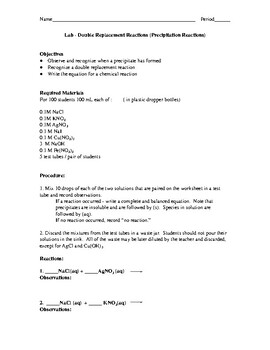
LAB Chemistry - Double Replacement/Precipitate Reactions (no chart - 5 selected)
Engage your chemistry students by having them observe precipitate reactions and practice writing the products of a chemical reaction (5 reactions). I chose to select 5 reactions rather than the traditional chart precipitates for the sake of time, fitting it into one period as well as clear equation writing for students.Objectives:Observe and recognize when a precipitate has formedWrite the products for a chemical reactionMaterials:0.1M NaCl 0.1MKNO30.1M AgNO3 0.1 M NaI1 M Cu(NO3)22 M NaOH 0.1 M
Subjects:
Grades:
9th - 12th, Higher Education
Types:

LAB Chemistry - Precipitates, Stoichiometry & Predicting Reaction Products
Engage your chemistry students by having them observe precipitate reactions and calculate how much product was produced. (It is not directly related mathematically, but they love that they can see what they made).Objectives:Observe and recognize when a precipitate has formedWrite the equation for a chemical reactionCalculate the amount of product formedMaterials:test tubes (5)test tube rackDropper bottles or beakers with pipettes of the following: 0.2 M for each solutionNaCl(aq) AgNO3 (aq)KNO3(a
Subjects:
Grades:
9th - 12th, Higher Education
Types:

LAB Chemistry Gas Laws - Diffusion
Engage your chemistry students by having them observe and perform an experiment to observe gas diffusion in real time. Watch as the colors change and the gas expands out throughout the container; the contents also show how gasses hit the outside first and slowly diffuse inside an area.Materials:Petri dish Dropper bottles of BTB1 M HCl, 1 M NaHSO3
Subjects:
Grades:
9th - 12th, Higher Education
Types:

LAB Chemistry - Single Replacement VS Double Replacement with Practice Problems
Engage your chemistry students by having them perform two quick reactions, with a fun color change. They will write out a full equation for the reaction observed (problem solving) as well as a quick recap of the 2 types of chemical reactions. Included:1 sheet Lab1 sheet 13 balancing & identifying reactions problemsObjective: Observe and predict the reactants of a single and double replacement reactionMaterials:BeakersDroppersGraduated CylindersMagnesiumHydrochloric AcidPotassium IodideLead (
Subjects:
Grades:
8th - 12th, Higher Education
Types:
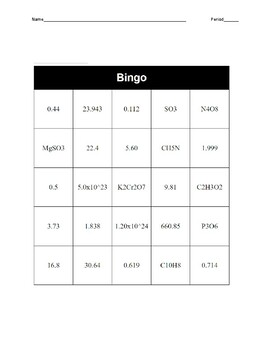
ACTIVITY /Review - Chemistry Mole Conversions, Empirical/Molecular Formula BINGO
Engage your chemistry students by having them work around the room in a competition to win BINGO with 5 in a row. Boxes are earned by finding the correct problems scattered around the room AND getting the correct answers.Included:Answer KEY 3 pages10 Different BINGO Cards with varied answers on cards/positions
Subjects:
Grades:
9th - 12th, Higher Education
Types:
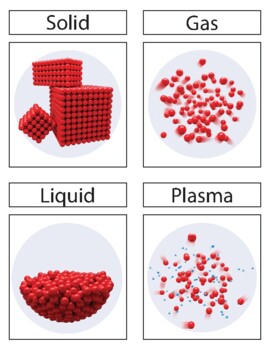
Phases of Matter 3-part cards
These are cards inspired by the Montessori 3-part cards. The four phases of matter covered are: solid, liquid, gas and plasma. For each set there are a matching set to print and cut out and a control set that can also be printed. The 3 sets are:- Pictures: for the younger learners, ESL, and/or to encourage questions. - Atomic structure models: to see at the atomic level what is happening in each phase. - Information: A summary of the main ideas to know when starting to study these concepts, as w
Subjects:
Grades:
4th - 12th
Types:

Density Displacement Lab-Metal Cylinders
In this lab you will use water placement and mass to calculate the density of an unknown metal cylinder. The easiest set to get is from Flinn Scientific and contains the 4 cylinders that are being tested. I used this assignment as a summative to reinforce concepts learned throughout the unit. This can be done with partners and requires minimal lab materials.
Subjects:
Grades:
7th - 12th
Types:
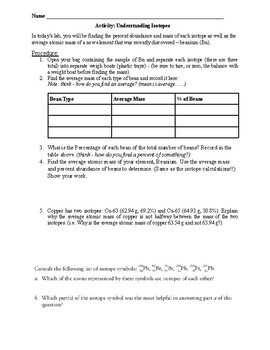
LAB Chemistry - Simplified Isotope Beans
Engage your chemistry students by having them calculate the isotope abundance of a fake element "beanium". This classic simulation has been altered to be more clear and concise.Included:1 sheet LabObjective: Calculate the atomic mass for a fake element to simulate isotope calculationsMaterials:scales/balances3 types of beans - thrown into baggies for students.
Subjects:
Grades:
8th - 12th, Higher Education
Types:
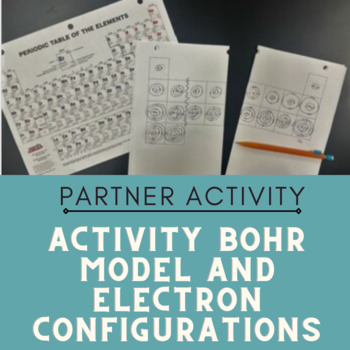
PARTNER ACTIVITY: Making Connections- Bohr Models & Electron Configurations
Students will first draw Bohr models (split their sheet in half for partners!) & look for trends in their drawings. Next, students will write the electron configurations for each element (1-18) and determine similarities. Then, students will highlight to connect each of their discoveries.This activity is typically better in partners where students can discuss and look for patterns together:Honors level - one dayNormal level - 2 daysLower level - 2 days with walk through of #1's question.
Subjects:
Grades:
8th - 12th
Types:
Showing 1-24 of 27 results









